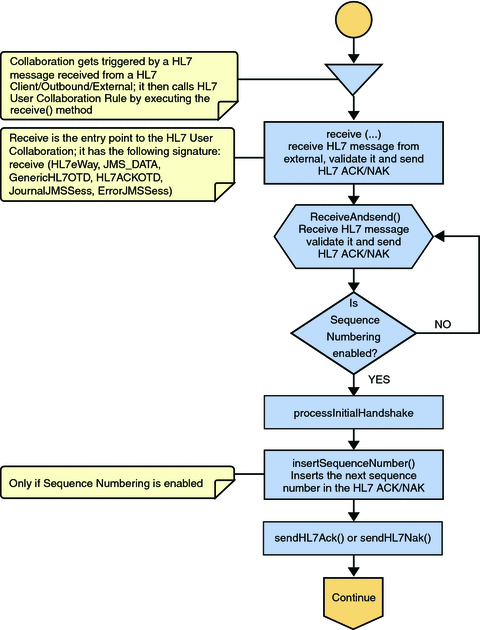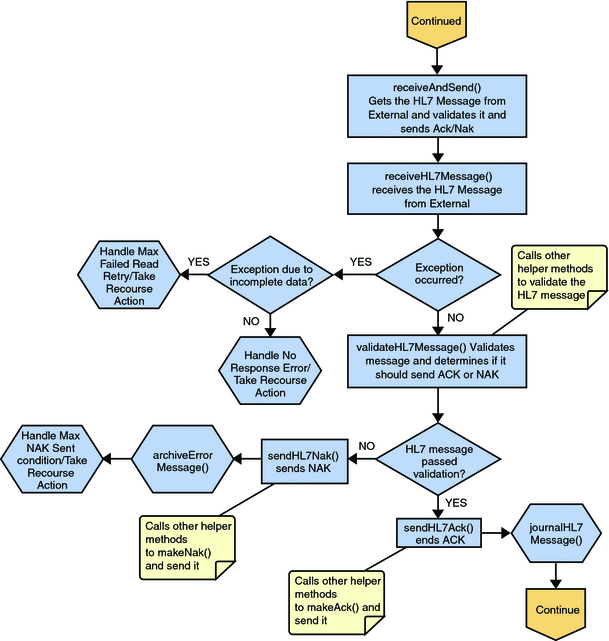Inbound HL7 V2 Collaboration Overview
The Inbound HL7 V2 Collaboration, jcdHL7inbound, contains OTDs for the HL7 Resource Adapter, JMS Data, HL7 ACK, JMS Journal, and JMS Error, as well as the Generic HL7 Event. The Collaboration works with its own internal code and the Properties Configuration files.
Inbound HL7 V2 Collaboration - Part 1
The inbound Collaboration is triggered by an HL7 V2 message received from an external system or an outbound HL7 V2 Client. The Collaboration calls the HL7 V2 User Collaboration Rule by executing receive().
The receive method is the entry point to the HL7 V2 User Collaboration, with the following signature:
public void
receive(com.stc.connector.appconn.tcpip.hl7.HL7ServerApplication input,
com.stc.connectors.jms.JMS otdJMS_DATA,
com.stc.SeeBeyond.OTD_Library.HL7.Generic.HL7_GENERIC_EVT.GENERIC_EVT
otdHL7_GENERIC_EVT_1,
com.stc.SeeBeyond.OTD_Library.HL7.Generic.HL7_ACK.ACK
otdHL7_ACK_1,com.stc.connectors.jms.JMS otdJMS_JOURNAL,
com.stc.connectors.jms.JMS otdJMS_ERROR) throws Throwable.
Once the message is received, the Collaboration determines whether the message needs to be validated. The HL7 V2 message is then validated making sure that the message structure is correct. Various fields in the MSH segment of the message are also validated, such as Version ID and Sending Facility. If these fields do not match the configuration, a NAK is returned.
If sequence numbering is enabled the Collaboration checks to see if the messages sequence number is valid. If the sequence number is not valid, the adapter sends a NAK.
The validated HL7 V2 message moves on to processInitialHandshake() and the sequence numbers are synchronized. The sequence number within the message is checked against the expected sequence number. If the numbers match, the Collaboration sends an ACK, if not it sends a NAK. The ACK or NAK includes information from various fields of the incoming MSH segment. The ACKs level of acknowledgement is set to A (acknowledgement is sent after the message is successfully processed) , or C (acknowledgement is sent when the message is successfully received).
Figure 1–1 Inbound HL7 V2 Collaboration - Part 1

Inbound HL7 V2 Collaboration - Part 2
The Collaboration receives the HL7 V2 message from the external using receiveHL7message(). If an exception occurs due to incomplete data, and the adapter fails to read the data within the configured number of retries, the associated recourse action is taken. If the exception is due to no response, the associated recourse action is taken.
If no exception occurs, validateHL7Message() is called, which validates the message to determine whether to ACK or NAK the message. Other helper methods are also called to validate the HL7 V2 message.
If the HL7 V2 message does not pass validation, the Collaboration calls makeNak() and sendHL7Nak() to create and send the NAK to the external. The HL7 V2 message, with the NAK, is archived to the Error Queue. If the number of consecutive NAKs sent surpasses the maximum number of retries, the associated recourse action is taken.
If the HL7 V2 message passes validation, the Collaboration calls makeAck() and sendHL7Ack() to create and send the ACK to the external.
Figure 1–2 Inbound HL7 V2 Collaboration - Part 2

Inbound HL7 V2 Collaboration - Part 3
After the ACK is sent, the HL7 V2 message and the ACK are journaled to the JMS Queue Journal destination. If the message fails to journal the associated recourse action is taken.
If Sequence Numbering is enabled, the processAckNakSequenceNumbering method calculates the next sequence number and stores the number in the sequence number file by calling the updateSequenceNumberFile method to persist the next sequence number.
Figure 1–3 Inbound HL7 V2 Collaboration - Part 3

- © 2010, Oracle Corporation and/or its affiliates
